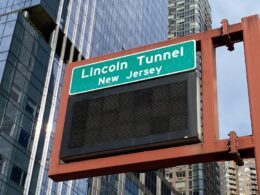The orange skies and flooded streets that have become all too familiar in recent years are more than just climate change warnings — they’re a call to reimagine some of the basics of how our cities work. In New York, we have a unique opportunity to transform environmental challenges into a blueprint for urban resilience. One element that must be at the core of that plan is something that isn’t often associated with climate solutions: a plan that helps families thrive.
In many ways our city is already a climate success story. New Yorkers generate about a third of the carbon emissions of the average American, thanks to our dense living patterns, robust public transit, and vertical housing. Yet as a city we face a fundamental challenge: new parents leave. Between April 2020 and July 2023, New York lost nearly 550,000 residents, with a staggering 17% drop in children under the age of five.
This exodus isn’t just a demographic shift — it’s a failure of urban design. Our world-class subway system, which transports millions so efficiently, is nearly impossible to navigate with a stroller. Our housing crisis pushes parents seeking more space into carbon-inefficient suburbs. Far too many neighborhoods lack the green spaces where children can play and that would absorb both stormwater and carbon.
But here’s the exciting part: solving our climate challenge and our family retention problem are deeply interconnected.
According to the city’s Green Economy Action Plan, 400,000 green jobs could contribute $89 billion to our economy by 2040 solving environmental and efficiency challenges. Crucially, many of these jobs offer family-sustaining wages and clear career pathways. One of the challenges, though, is making this transition in a credible and accessible way.
Though the last federal administration invested more in decarbonization and adaption than any government anywhere in history, after three years many Americans felt that their lives had improved little, and for others, climate compliance has felt like added costs with few tangible benefits.
The key to getting onto these paths is thoughtful, inclusive cross-sector collaboration, like that being spearheaded by the New York Climate Exchange, to ensure workers across industries can adapt to green jobs with new technologies, without disruption. This isn’t about replacing workers, but evolving skills — a welder, for instance, might move from welding gas pipelines to welding wind turbines, maintaining their expertise while building a sustainable future.
But some of the most critical infrastructure for our green, family-friendly future is child care. A 5BORO Institute report highlights a stark reality: from 2020-2022, approximately 375,000 parents — mostly mothers — cut back on or left careers due to a lack of affordable child care, to say nothing of those who left the city outright.
This trend may only be getting worse; research from Robin Hood showed that more than half of working mothers in the city had a career disruption in the past year because of child care challenges.
In the recent citywide People’s Pulse survey from the 5BORO Institute and its four foundation partners, 17% of New Yorkers surveyed reported having to stop work, reduce hours, or change jobs in order to accommodate child care responsibilities. The cost of child care is also skyrocketing, with family day care center rates for infants doubling in just five years since the start of the pandemic.
An insufficient supply of care for children — and care that is too expensive — limits parents’ participation in green or any work — keeping that work from getting done.
New York City’s universal Pre-K and 3K programs offer a model of success. By supporting working parents, these initiatives aren’t just providing child care and education — they’re economic engines, allowing parents to return to careers sooner. Initiatives like this have been shown to generate returns beyond most other economic development investments; in Quebec, the growth in income tax revenue from parents who engaged in the workforce because of universal child care more than covered the program’s cost.
On the national side, the bipartisan CHIPS Act requirement that manufacturing companies receiving grant funding provide child care for their workers has already demonstrated results for businesses, families, and educators. Even with those federal efforts at risk, local and state-level economic development agencies could adopt similar requirements.
Supporting families and fighting climate change need not be competing priorities. In fact, they are deeply complementary goals because a green city is a child- and family-friendly city. A sustainable, family-centered future only works if we have better child care.
Hammer is the CEO of The New York Climate Exchange. Rauh is the executive director of The 5BORO Institute.








